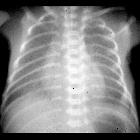Ambulant erworbene Pneumonie

Community-acquired pneumonia (CAP) refers to pneumonia caused by an infectious agent that is contracted in the general population, and not whilst in a medical facility, or from contact with the healthcare system. A diagnosis of CAP may still be reached up to 48 hours post-admission to hospital .
Terminology
Severe community-acquired pneumonia is a subtype of pneumonia for which critical care provided supportive management is needed, incurring markedly elevated mortality .
Epidemiology
Community-acquired pneumonia has an estimated annual incidence of 1.6 to 10.6 per 1000 adults in Europe . The incidence of CAP correlates with increasing age, and most mortality from severe community-acquired pneumonia is found in the over 70 years of age cohort .
Streptococcus pneumoniae (also known as pneumococcus) is the commonest causative agent of community-acquired pneumonia worldwide .
Risk factors
Certain factors increase the risk of severity of CAP, and whether atypical organisms may be responsible including :
- older age
- cardiorespiratory comorbidities
- poor initial performance status
- low socioeconomic group
- new weight loss/cachectic state
Clinical presentation
Community-acquired pneumonia most typically presents with a cough, breathlessness, pleuritic pain, pyrexia, and lassitude. It is important to remember that these symptoms, whilst classical, can be subdued/absent, especially in the immunocompromised and elderly.
Often accompanying the symptoms, are clinical signs, including tachypnea and tachycardia.
Pathology
Etiology
The development of pneumonia follows the inhalation/aspiration of a pathogen which overwhelms the natural defenses of the lungs. Unsurprisingly, this is more likely to happen when the organism is virulent and/or if the immune system is compromised.
Streptococcus pneumoniae (pneumococcus) remains the commonest etiologic organism for all ages. Many other organisms can cause pneumonia, and the following pathogen list is not intended to be exhaustive but demonstrates common risks for succumbing to them and typical associated features :
-
- risk factors: alcoholics, HIV, IV drug use, hyposplenism
- features: pleural effusions, empyema
-
- risk factors: pre-existing pulmonary disease, IV drug use, influenza
- features: cavitation, pneumothorax
- methicillin-resistant Staphylococcus aureus (MRSA)
- risk factors: pre-existing influenza
- features: necrotizing pneumonia, cavitation, neutropenia, skin pustules
-
- risk factors: smoking, overseas travel (cruise ships, hotels)
- features: CNS involvement, renal impairment, diarrhea, transaminitis, relative bradycardia
- gram-negative bacilli
- risk factors: immunocompromised, recent antimicrobials, pre-existing pulmonary disease
- risk factors: immunocompromised, recent antimicrobials, pre-existing pulmonary disease
- Klebsiella pneumoniae
- risk factors: alcoholics, aspiration
- features: leukopenia, cavitation, empyema
- Acinetobacter baumannii
- risk factors: alcoholics, aspiration
- risk factors: alcoholics, aspiration
- Pseudomonas aeruginosa
- risk factors: pre-existing pulmonary disease, smoking, aspiration, HIV
- risk factors: pre-existing pulmonary disease, smoking, aspiration, HIV
- Haemophilus influenzae
- risk factors: aspiration, COPD, smoking, HIV, IV drug use
- risk factors: aspiration, COPD, smoking, HIV, IV drug use
- Moraxella catarrhalis
- risk factors: COPD, smoking
- risk factors: COPD, smoking
- Mycoplasma pneumoniae
- risk factors: cyclical epidemics
- features: headaches, erythema multiforme, +ve cold agglutinins
- Chlamydophila pneumoniae
- risk factors: COPD, smoking
- features: interstitial opacities
- Chlamydophila psittaci
- risk factors: contact with birds,
- features: interstitial opacities, Horder spots (rose spots on the face), transaminitis
- Mycobacterium tuberculosis
- risk factors: alcoholics, IV drug use, HIV
- risk factors: alcoholics, IV drug use, HIV
- anaerobes
- risk factors: aspiration, alcoholics, IV drug use
- risk factors: aspiration, alcoholics, IV drug use
- respiratory viruses
- risk factors: viral epidemics
- features: interstitial opacities
- Histoplasma capsulatum (especially central/eastern USA)
- risk factors: contact with bird/bat excreta
- risk factors: contact with bird/bat excreta
- Coxiella burnetii (Q fever)
- risk factors: contact with farm animals
Severe community-acquired pneumonia
Common causative organisms for severe CAP are:
- Legionella spp.
- Staphylococcus aureus
- gram-negative bacilli
- influenza spp.
NB: in up to one-third of cases of community-acquired pneumonia no etiologic pathogen is ever identified .
Complications
Radiographic features
Plain radiograph
Most patients will have a chest radiograph, which most commonly demonstrates an air space consolidation appearance, classically a lobar pattern in pneumococcal disease. However a wide spectrum of radiographic changes may be found, and several organisms are well-known for having an interstitial, rather than consolidative, appearance. Notwithstanding the above, it is inadvisable to try and diagnose the specific responsible organism from its radiographic pattern.
Ultrasound
Chest sonography is demonstrating increasing promise as an investigative modality for pneumonia.
CT
CT chest is usually reserved for cases that are refractory to treatment or for the assessment of potential complications such as lung abscess or empyema .
Treatment and prognosis
Follow-up imaging post CAP is not recommended by the American Thoracic Society when symptoms resolve within 5-7 days . The positive yield of follow-up imaging is ~2.5% (range 0.2-5.0%) .
Siehe auch:

 Assoziationen und Differentialdiagnosen zu Ambulant erworbene Pneumonie:
Assoziationen und Differentialdiagnosen zu Ambulant erworbene Pneumonie:





